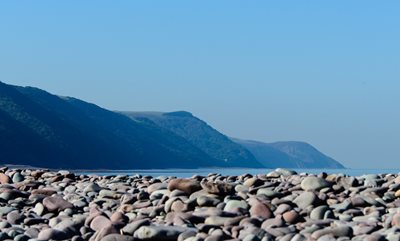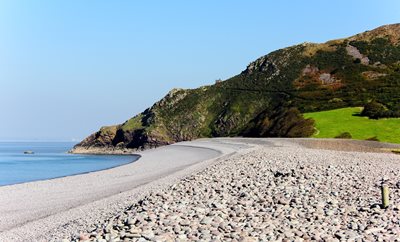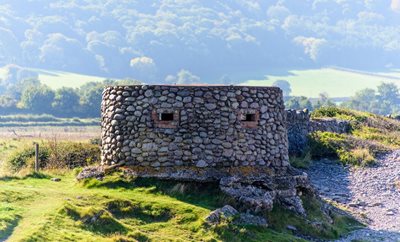inbscribed and dated "A Bridge at Bossington nr Minehead Aug 1864" and signed with initials "LWT"
Tom and Laura Taylor and thence by descent
The coastal hamlet of Bossington sits within the National Trust’s Holnicote Estate, which covers 12000 acres of Exmoor National Park. From the south, the village is separated from West Lynch by farmland and Horner Water, which is crossed by Green Bridge. Bossington Green is an area of grass criss-crossed by roads and populated with small and medium trees a guide post and bus shelter. At the north end, are a pair of 20th semi-detached cottages, while to the east on the other side of the river and on the hill slope is Lynch Mead, a large detached residence in its own grounds. Both these developments are atypical.Green Bridge crosses the wider Horner Water and has a boundary stone (re)set into the parapet marked ‘PP SP’ (Porlock Parish - Selworthy Parish).
Bossington & Allerford are two tiny but terrific neighbouring villages along the coast of Exmoor, just east of Porlock. About 15-20 mins walk (or 4 mins drive) apart, they are both within the National Trust’s Holnicote Estate and, together, make up quite honestly a fairytale location for a staycation. Whatever the weather, Bossington boasts breathtakingly dramatic views and Allerford enchants everyone.
Bossington Beach is a beautiful place to walk, picnic or paddle. It curves along the bay for nearly 3 miles to Porlock Weir and feels amazingly expansive, looking out across the water to Wales. Swimming is only advised in calm weather, and you want stay close to the shore as there are some very strong currents but this does mean you’ll find the pebbles on this beach have been sorted according to size by the sea! The beach backs onto Porlock Marsh – a fascinating part of the environment which offers saltmarsh and freshwater habitats for a wide variety of wildlife.
Bossington Beach is a pebble beach at the eastern end of Porlock Bay. Park at the pretty village of Bossington and take note of Kitnors tearoom situated next to the car park. It’s a very welcome place for refreshments after your walk to the beach. 
The beach and the surrounding landscape is a very interesting place, where the shingle acts as a barrier to the adjacent marshland and a number of rare bird and insect species live behind this natural wall. Evidence of the Second World War is evident as well, with pillboxes and a ruined control centre situated on the edge of the pebbles. A walk of 2.5 miles from the Bossington Car Park will take you onto the beach, to the gun emplacements and then along the shingle to the old coastguard lookout station beneath the rocky outcrop.
A walk of 2.5 miles from the Bossington Car Park will take you onto the beach, to the gun emplacements and then along the shingle to the old coastguard lookout station beneath the rocky outcrop.
A peculiarity is the River Horner, which seems to disappear as it approaches the bay. After creating the marshes behind the beach, the river soaks into the shingle, where it filters into the sea via many small underground rivulets.
The peace and quiet of much of the Somerset Coast belies its past which at certain periods was far from either, particularly during the time when the County was the base for King Alfred’s resistance to the Vikings. If you look out to the island of Steep Holm, so named because it was where the Danes over-wintered ready to invade, you can perhaps imagine the distinctive boats setting sail for the shore fortified to repel them.
Laura Wilson Barker (6 March 1819 – 22 May 1905), was a composer, performer and artist, sometimes also referred to as Laura Barker, Laura W Taylor or "Mrs Tom Taylor".
She was born in Thirkleby, North Yorkshire, third daughter of a clergyman, the Rev. Thomas Barker. She studied privately with Cipriani Potter and became an accomplished pianist and violinist. As a young girl Barker performed with both Louis Spohr and Paganini. She began composing in the mid-1830s - her Seven Romances for voice and guitar were published in 1837. From around 1843 until 1855 she taught music at York School for the Blind. During this period some of her compositions - including a symphony in manuscript, on 19 April 1845 - were performed at York Choral Society concerts.
On 19 June 1855 she married the English dramatist, critic, biographer, public servant, and editor of Punch magazine Tom Taylor. Barker contributed music to at least one of her husband's plays, an overture and entr'acte to Joan of Arc (1871), and provided harmonisations as an appendix to his translation of Ballads and Songs of Brittany (1865).
Her other works include the cantata Enone (1850), the violin sonata A Country Walk (1860), theatre music for As You Like It, (April 1880), Songs of Youth (1884), string quartets, madrigals and solo songs. Her choral setting of Keats's A Prophecy, composed in 1850, was performed for the first time 49 years later at the Hovingham Festival in 1899. The composer was present.
Several of Barker's paintings hang at Smallhythe Place in Kent, Ellen Terry's house.
Barker lived with her husband and family at 84 Lavender Sweep, Battersea. There were two children: the artist John Wycliffe Taylor (1859–1925), and Laura Lucy Arnold Taylor (1863–1940). The Sunday musical soirees at the house attracted many well-known attendees, including Lewis Carroll, Charles Dickens, Henry Irving, Charles Reade, Alfred Tennyson, Ellen Terry and William Makepeace Thackeray.
Tom Taylor died suddenly at his home in 1880 at the age of 62. After his death, his widow retired to Porch House, Coleshill in Buckinghamshire, where she died on 22 May 1905, aged 86.

